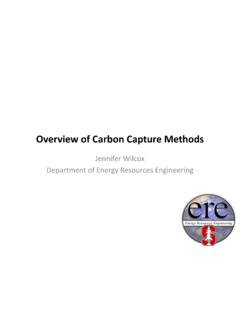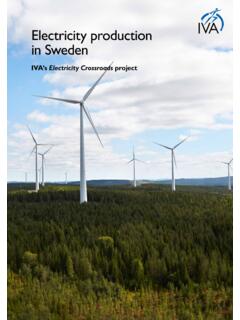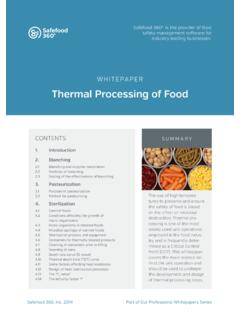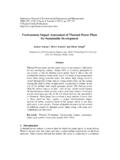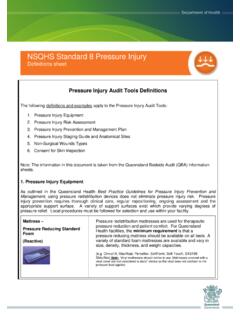Transcription of Production of Hydrogen - Stanford University
1 Production of HydrogenRJ AllamAir Products3 Why Hydrogen ?H2+ O2 H2O H kcal/molezH2is an energy vector, is converted to water which has minimal environmental a non-polluting fuel for transportation vehicles and power productionzCurrently road vehicles emit about the same quantity of CO2as power Production . zH2can be produced from fossil fuels with CO2capture and storage or from renewables4 Production of HydrogenOptionsCharacteristicsMethodFoss il fuelsPresentNon fossil fuel alternatives based on sunlight, renewables and nuclearFar FutureHeat, water, oxygen, catalyticFossil fuel Conversionfreeze equilibrium mconc as function of temphigh temperaturewaterThermal splittingambient high pressureambient high temperaturePower for electrolyserwaterElectrolysiscatalytic-w ater splittingPhotolysis5 Carbon Containing FuelsEthane Fuel OilRefined HydrocarbonsTar PetcokeHeavy refinery wasteBiomassNatural gasLignite AnthraciteCoal6 ReactionsCH4 2H2+ C + HThermal DecompositionOnly limited application as co-product in carbon black manufactureC + O2 CO - HCO + H2O CO2+ H2- HPartial
2 Oxidation - Non CatalyticAny hydrocarbon or carbonaceous feedstockCH4+ H2O CO + 3H2+ HCO + H2O H2+ CO2- HReforming With Steam - CatalyticNatural gas and light hydrocarbons7 General Arrangement For CO2-free Hydrogen ProductionFuelSyngas GenerationH2purification / CO2separationWaste Fuel GasCO2 OxygenShift reactorsHeat RecoveryExport SteamSteamH28CO2 Separation TechnologiesCapabilities AdsorptionMembrane AbsorptionCryogenicFeed Pressure Low to HighMedium to High Low to HighMedium to High CO2 Pressure Low Low Low Low to Medium CO2 Purity Medium to High Low to Medium Medium to High High CO2 Recovery Medium to High Low High High 9H2 ProductionSeparation MethodsSeparation of pure H2and pure CO2from syngasAbsorptionScrubbing with a solventPhysical solvents.
3 Rectisol low temperature methanolSelexol PolyetherSelective for H2S and CO2following COS hydrolysisFavour high partial pressure of impurityUsed primarily when POX coal/tarChemical solvents usually based on aminesSingle component absorption H2S and CO2 High heat requirementSuitable for low partial pressure of impurity1011H2 ProductionSeparation MethodsSeparation of pure H2and pure CO2from syngasAdsorptionzPressure swing used for most H2separations from syngaseszCan achieve 90% H2recovery from 22 bar SMR gas. Typical 3-10 min cycle timezLow capital cost, high reliabilityzCan be used for simultaneous pure H2and pure CO2recovery at high purity1213 Process CharacteristicsOpen SystemszExternal heating of a catalytic reactorzCombustion products vented to atmospherezCO2-free flue gas requires H2fuel for the furnace, orzOxyfuel furnace operation could be ,000 Nm3/hr Steam Natural Gas Reformer14 Current TechnologySteam Methane Reforming (SMR)zLimitations Carbon formation at low steam.
4 Carbon ratio Higher Hydrogen pressure limits CH4conversion High CH4conversion requires high temperature Excess steam Production Cooling by waste heat boiler to limit Bouduard carbon formation Low NOxlevels required in stack gaszChallenges Reduce steam to carbon ratio Low NOxlong flame burners Materials limitations in alloys used for tubes Reduce excess steam Production by air preheat and pre-reforming15 Process CharacteristicsClosed Systems Pressurised reactors with heat supplied by direct oxidation with oxygen No venting of combustion productsAutothermal ReformerPartial OxidationNatural GasOxygenSteamNatural GasOxygenPOXC atalyst16 Current TechnologyAutothermal Reformer (ATR)zLimitations Must use a clean, light hydrocarbon feed Cost of oxygen Limitation in H2pressure Limitation in exit temperature Excess steam Production Needs waste heat boiler to limit Bouduardcarbon formationzChallenges Reduce steam to carbon ratio Increase CH4conversion by increasing temp Carbon free burner operation Increase in vessel size/throughout17 Current TechnologyPartial Oxidation (POX)
5 Suitable for any carbonaceous feed favoured for coalMany bed LurgizFluidised bed WinklerzEntrained bed (1325 C 1450 C) Texaco water slurry coal feed high pressure: 70 bar usually water quench favoured for H2production because of excess H2O present combined sour gas CO shift and COS hydrolysis Shell dry coal feed, nitrogen entrainment pressure limitation: 40bar (coal) waste heat boiler, higher efficiency needs added steam for shift and H2production often configured with a COS hydrolysis reactor upstream of H2S removal and CO shift reactor downstream of H2S removal18CO2-Free Power and Hydrogen From Coal Fuelled SystemCoalCoal GasificationCO2/H2S PhysicalAbsorptionSystemH2for Power Generation100 bar CO2 Water/N2 OxygenShift reactorsH2 ProductQuench/Heat RecoveryAsh/SlagH2 PurificationTexacoShellOXYGENN219 Production of HydrogenATR/GHR IntegrationProductH2+ CO600 C+ATRS team Reforming (open ended tubes)
6 SteamNatural GasOxygen1050 CSteamzPossibility of using high temperature H2/CO/CO2syngasto heat a Gas Heated Reformer (GHR)zNo excess steam productionzExtra 30% H2productionzBouduard carbon formation in GHR shell side20H2 ProductionEmerging TechnologieszMicro reactor/Multichannel Heat ExchangerEither Low temperature POX Air purified 45% H2 fuel cell feed (PEM) Followed by direct air/CO Oxidation to reduce CO<10ppmzSMR Separate air/fuel gas catalytic combustion passages and adjacent SMR passages21 Production of HydrogenPlate-Fin ReformerCatalyst can be a surface coating or a porous to match the heat release rate with the steam hydrocarbon reforming compact and potentially low cost systemFuel Gas + AirNatural Gas + SteamMetalMetalMetalMetal22H2 ProductionEmerging TechnologieszMicro reactor/Multichannel Heat ExchangerIn General Catalyst can be deposited on metal surfaces or used in a porous insert Removable catalyst
7 Elements are possible Very high volumetric productivity for SMR reactor Whole H2plant can be integrated with a plate-fin reformer configurationChallenges Novel arrangements to allow catalyst change out Capable of either small scale or very large scale use Requires balanced performance between SMR/fuel combustion23 ITM Hydrogen /Syngas: A Revolutionary Technology Using Ceramic MembraneszIon Transport Membranes (ITM) Non-porous multi-component ceramic membranes High oxygen flux and high selectivity for oxygen Operate at high temperatures, typically over 700 CzITM Hydrogen /Syngas combines air separation and methane partial oxidation into a single unit operation.
8 Resulting in significant cost savingsCH4 + O2- CO + 2H2 + 2e- O2 + 2e- O2-O2-2e-SyngasAirSpent AirMetal cationITM MembraneOxygen anionOxygen vacancyCH4 Natural Gas & SteamH2 CONitrogenOxygenH2O24 Integrated Development Program Addresses Key Technical Challenges with Broad Development TeamMaterialsDevelopmentTestSystemsDesig n &AnalysisCeramicProcessing Develop fabrication methods Produce ceramic membranesfor testing Develop stable materialcompositions Characterize material properties and performance Lab-scale testing: ambient pressureand elevated pressure Process Development Unit (PDU) SEP and PCTDU Process design andeconomic evaluation Membrane and reactor design25 Advantages of Planar Membrane SystemsCeramic Wafer StackAir Feed (internal)Air Feed (internal)Natural Gas Feed (external)Natural Gas Feed (external)SyngasSyngasProducts (HProducts (H22and CO)and CO)
9 Active MembranePorous Support/CatalystFlow ChannelszCompactnesszGood mass and heat transferzAmenable to standard ceramic processing methods26 PDU Ceramic Membranes Contain Essential Features of Full-Size Commercial MembraneszITM Hydrogen /Syngasceramic membranes have internal features for manifolding and air flow, while supporting > 400 psi pressure differentialzMembrane fabrication processes are robust and scaleableAir Flow(internal)Natural Gas/SyngasFlow (external)27 ITM Hydrogen /Syngas: Combines Oxygen Production and Syngas Production Into a Single Reactor to Achieve Over 30% Capital Cost SavingsConventional Process (ATR and Air Sep Unit) with Separate Oxygen and Syngas ProductionITM Hydrogen /Syngas Reactor Combines Oxygen Separation and Syngas ProductionAutothermalReformerOxygenNatur alGas FeedSteamFuelFeed Preheatand TreatmentSyngastoProduct ConversionSyngasto ProductConversion:( Hydrogen ,clean liquid fuels,chemicals)ITM H2/SyngasReactorin-lineburnerFuelAirblow erMain AirCompressor-Front EndCleanupMain Heat



